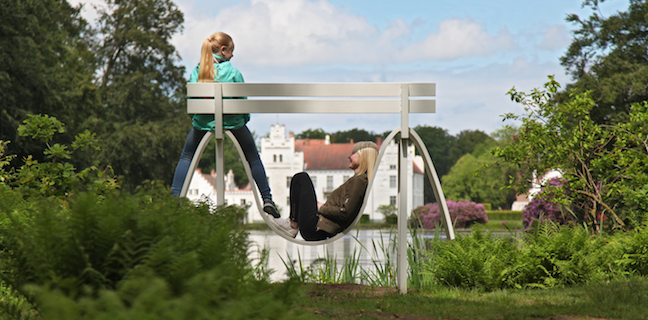
Jeppe Hein
(Född/Born 1974, verksam i/works in Berlin)
Modified Social Bench #11, 2012
Pulverlackerad aluminium/Powder-coated aluminium
Varierande mått/Dimensions variable
Med stöd från/With support from Wanås Konst Artlover
For English please scroll down
Jeppe Hein har arbetat med bänkar sedan år 2000. Med ett konstnärligt angreppssätt förändrar Hein bänkens förväntade konstruktion för att skapa dialog mellan konstverket och betraktaren. Bänkarna pendlar mellan att vara en funktionell möbel och ett dysfunktionellt konstverk och bjuder in till aktivitet, lek och social gemenskap. Bänken var en av sju i Jeppe Heins utställning Ett leende till dig 2013, som fokuserade på lycka. Hein beskriver själv: ”Som offentlig arkitekturs vardagliga möbler kan bänkar både erbjuda gemensam plats och enskild vila. Å andra sidan ger bänkar utmärkt möjlighet till kommunikation och social interaktion och dessutom ett ögonblicks andrum. Därigenom påverkar bänkar människors beteende i offentligheten och ger dem möjlighet att uppmuntra till, eller avskräcka från, att andra tar plats bredvid dem. Att utveckla kommunikativa bänkar och placera dem på offentliga platser anser jag är en respektfull metod och närmande av en plats i form av en aktiv politisk intervention.”
Genom frågor om hur lycka känns, smakar och luktar reflekterade besökarna 2013 över lyckobegreppets personliga och allmänna betydelser. I utställningen skrev Hein frågan: ”Vad är lycka för dig?” med två meter höga bokstäver av trädstammar vid infarten till Wanås. Konsthallen förvandlades till en workshop där hans verk och instruktionen WORK SHOP/RIGHT HERE/RIGHT NOW uppmanade besökarna att själva göra. På dammen ledde en lång brygga ut till en stor cirkelformad bur med en spegel inspirerad av Alexander Calders miniatyrcirkus. Spegeln återkommer hos Hein och han har under många år haft en dialog med Dan Graham som också återkommer till samma material.
>>>
Working with benches since 2000, Jeppe Hein transforms the expected construction of the bench to create a dialogue between the artwork and the observer. The benches are both a functional piece of furniture and a dysfunctional artwork, inviting activity, play, and social interaction. This bench was one of seven in Hein’s exhibition A Smile for You from 2013. He says: “As the everyday furniture of public architecture, benches can both offer a common space and personal rest. On the other hand, benches give great opportunities for communication and social interaction, in addition to a moment’s respite. Benches thereby impact people’s behavior in public and give them the opportunity to encourage, or deter, others from sitting beside them. Developing communicative benches and placing them in public places is a respectful method, in my opinion, and approaches a place in the form of active political intervention.”
Through questions of how happiness feels, tastes, and smells, visitors in 2013 reflected on the concept of happiness, both for the individual and in general. In the exhibition, Hein wrote “What is happiness for you?” at Wanås’ entrance with two-metre-high letters made from tree trunks. In the Art Gallery his works and the instructions WORK SHOP/RIGHT HERE/RIGHT NOW encouraged the visitors to create things themselves. On the pond, a pier led to a circular cage with a mirror, inspired by Alexander Calder’s miniature circus. Mirrors recur in Hein’s work, and for many years he has had an ongoing dialogue with Dan Graham, who also returns to the same materials.